— Soaking in the Daily Curses: A Conversation
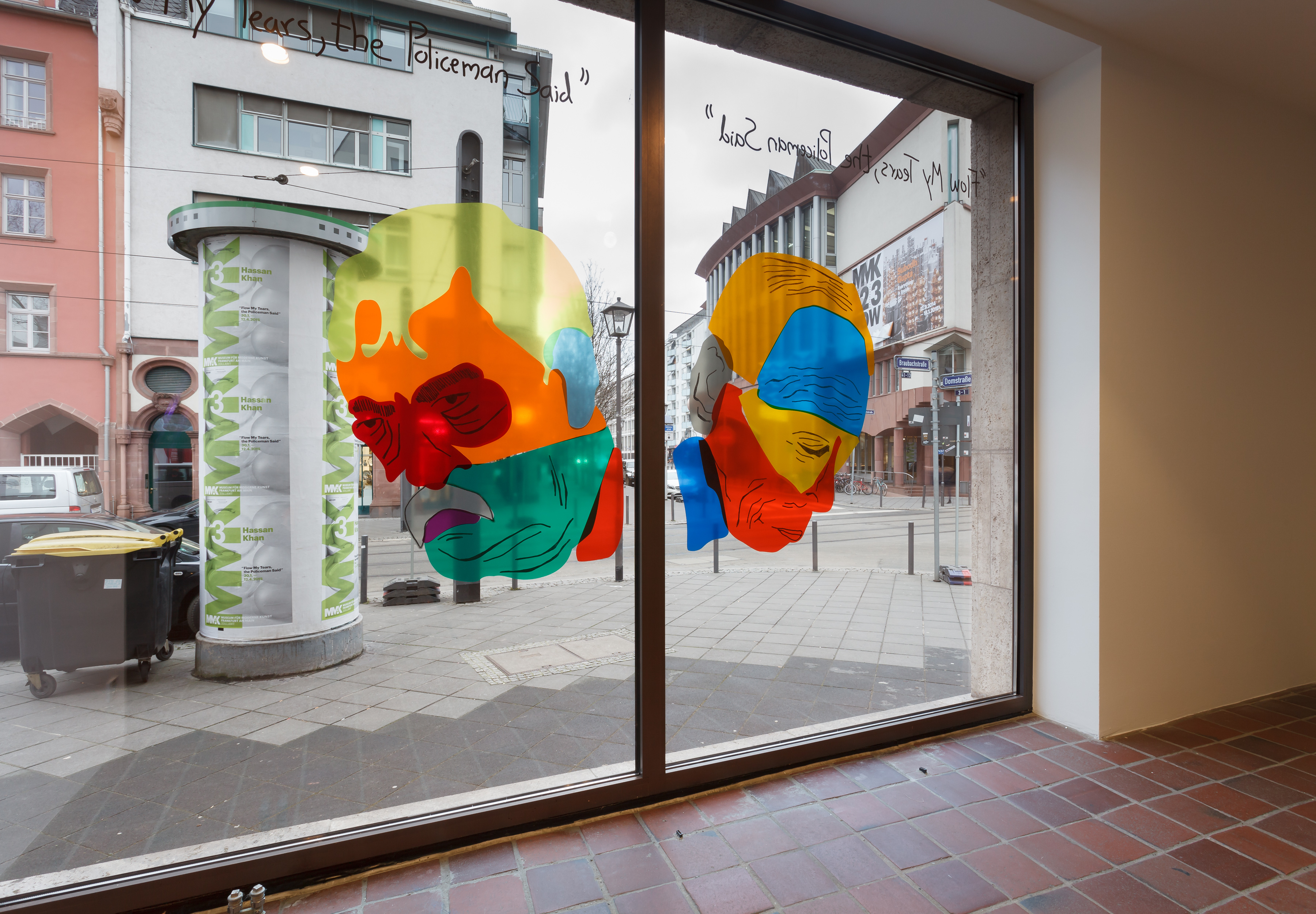
Natasha Ginwala: I wonder if we could think about corruption as something that already performs immanently in your various roles as an artist, musician, and writer, in the ways that these different approaches become entangled across processes of liveness and improvisation, in music, scripting and building film scenarios, and so forth.
Hassan Khan: Of course even the word “corruption” is very broad; there is direct political and financial corruption, there is entropy as a physical property, there is corruption as a condition of the social construct, and so forth. It’s really a bigger question with different sides to it. One aspect to begin with could be: How is corruption considered in terms of betrayal? As structural or endemic—or, if I want to be more specific and brutal, let’s say as part of my own career. What have I betrayed over these twenty years? I must have betrayed many things, because you cannot work in a context for twenty years without betraying things. Different things; from disrespecting the purity of mediums and their limits, to more or less accepting the dominant code of the context we operate in. However, because I’ve always been driven by my desires and a sense of responsibility to myself, I believe the work still remains active, alive, and conflicted. There might be a contradiction here between career as corruption and practice as corruption. In that sense, and almost by necessity, one thing I think I have not betrayed is my own selfishness.
NG: Your video work Conspiracy (dialogue/diatribe) doesn’t necessarily engage betrayal but raises a sense of distrust in the emotional spectrum of a conversation between two characters that surges from friendship into antagonism within a specific setting. How did you go about developing this plot and its characters?
HK: This piece is from 2006, and it was based upon several observations. It has a back story: I used to hang out in this cafe in Cairo that was close to where I lived then. Sometimes, in the morning, I’d have a coffee there. And there was always a typical downtown sort of big-city scene, in which a group of mostly men (sometimes one woman would be there), between their mid-forties up to eighty or so, would just be hanging out and reading the newspapers, insulting each other, idly squabbling. Sometimes the line between what is serious and not serious was blurred. Sometimes you felt there was real aggression behind it. Sometimes it was just faking the aggression, etc. But there was a miniature culture happening within that cafe, like a microcosm of the larger one.
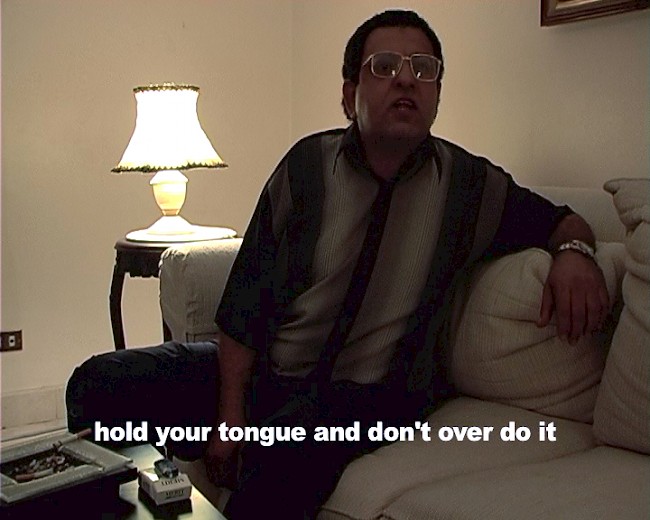
I was also a customer of the place, but I never partook in this ritual. And I never wanted to be friends with them. I had no interest in that. I just sat there. Had a coffee, read the papers, and I wasn’t even really eavesdropping. I was just soaking it in, soaking in the daily curses. And what I noticed was that these men were the middle management of the whole social order, in a way. So, you had small business owners, bureaucrats, technocrats, experts possibly working in a public company, such as a head accountant, for example. So they were all reasonably well-established, but they were not the big fish. They were just the facilitators, the managers of the system, the lubricants. And they had a lot to discuss. They even discussed actual cases of corruption. They talked over things that they were involved in, or heard about as part of their daily fodder, and of course they would discuss politics. Through these conversations, regardless of the content, they were constantly negotiating their relationship to each other, and the structure of this microcosm. This was my source-inspiration, these mornings.
Then I became interested in how one might produce a situation where the characters are both full and empty at the same time. The same shots are repeated in a different order six times to produce six different scenes. I wanted to treat the language itself—which is a slightly stylized form of daily language—as something that was automated, that almost had its own volition beyond the people using it. As if the words were sort of flowing through them rather than being produced by them. I wanted the two actors I worked with to posess that contingency but not to represent it.
It was very important for me for the aesthetics of that world to be handled with a certain precision. The type of sofa, the framed tapestry with the gold-thread calligraphy behind them on the wall, the horse sculpture—I wanted these elements to house meaning. Finally, the aesthetics of the piece itself, in the performance and how it’s shot and cut, should be derived from the popular aesthetics of TV soap operas and things like that, to an extent. Not as pastiche or irony, but rather to tap into what we might call the shared domestic bible of these things. There is no sound other than a human voice, which is something I return to in other works much later, like Blind Ambition (2012). And that was also important in relation to this empty feeling of a situation becoming possessed by words and their horizon.
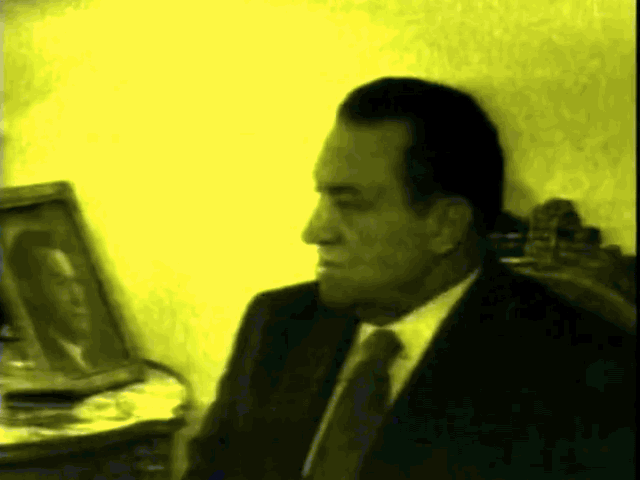
It’s called Conspiracy, and then in brackets (dialogue/diatribe). And what is a conspiracy but an agreement amongst people? That word was important for taking a rather normal, daily situation, a conversation between two people in a living room, and treating it as a conspiratorial act. To evoke the contract that allows a social order, and the individuals who constitute it, to function as such. An agreement is a constitutive moment, a conspiracy of betrayal.
NG: I would like to go back to even earlier in your practice and talk about Technicolor Mubarak (2001), as I feel that here you enter the realm of corruption, but literally through speech and visuality becoming a deficit, and even becoming incapacitated in a way—the loss of the image read in the transmission of the politician’s presence and speech.
HK: Yeah. This video has never been shown as its own piece actually. It’s been shown as part of Tabla Dubb, which was the music and video performance I premiered in 2001 and stopped performing in 2007 when the music was released as an album. So, in Tabla Dubb, one of the video sequences was Technicolor Mubarak. I don’t even know which originally came first, since this is fourteen years ago now. I guess what fascinated me about this at the time was just the fact that Mubarak was the ultimate sign, the sign that dominated the public sphere. And what caught me in these few seconds is that he’s sitting there, and there’s this photograph next to him of himself. He’s sitting next to his own photograph. His vanity (generic and unremarkable amongst dictators) is beside the point. There was just something inexplicably captivating in seeing that figure repeated in this way as an image of himself. The flashing colors in the video weren’t designed to make it funny. But it always elicited laughter, especially in Cairo, where the sign was more potent. I was just literally responding to what I found compelling in the figure and the figure, him and him. This strangely connects to a work from this year, Flow My Tears, the Policeman Said (2015), which is also the title of my recent solo exhibition in Frankfurt. This work uses two portraits, one of which is a particular judge who for me epitomizes corruption as a dangerous destructive political act. Just to be clear, he’s a judge who’s been handing out death sentences left and right. It’s almost like a joke, how even in his appearance he’s the “evil judge.” The system of power had to get someone who looks like that. He’s visually so stimulating, this man. I mean, he was a police officer before he became a judge. He’s just a nightmare. He is, in a way, a conscious representation of power at the moment. I truly believe it is no accident that he looks the way he does. I think that in dealing with this portrait, it’s important to mention that it was impossible for me to portray the relationship of a person like that to power in a way that was straightforward, literal, or descriptive.
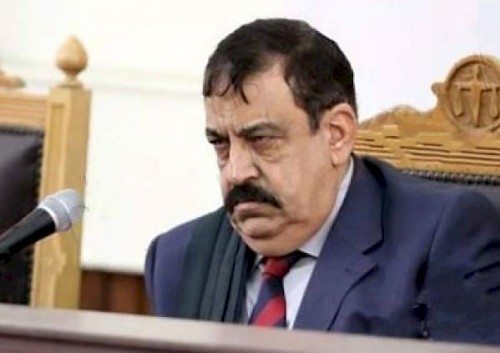
NG: What about Purity, which I saw at the Global Art Forum in 2013? In a way, it is structured completely differently, but raises a scripted situation in which, this time, you’re only mechanically engaging. So, of course, it’s an aural experience. And it feels as though the sonic composition is metronomic—nonhuman. While in Technicolor Mubarak, there is an audiovisual production, in Purity, you sit back and are intently listening to the script being enacted. But it also investigates purity through the question of justice, through a sense of seduction and secret orders.
HK: Yes, in Purity, when it’s performed live, I do sit back and listen to it. The only thing I do live is mix the music tracks, which is also a very simple mix. So it’s not as charged as when I’m performing a concert or something like that. I also feel that if I listen to it in a very focused, invested fashion, people will also listen to it in a focused fashion. Purity is quite complex. The starting point was Shumon Basar’s invitation to think of a word to speak about in less than fifteen minutes for the 2013 Global Art Forum at Art Dubai. Two words came up: “purity” and “promise.” In the end, I chose purity, because it was the one I felt more uncomfortable with, that I was more afraid of. I was afraid of it because it is a dangerous word. Many of the most brutal episodes in human history were predicated on this word. Political orders have based themselves on an assumed sort of purity, or purity as a desire, aspiration, or whatever. And at the same time, I did not want to tackle it by condemning it. It’s sort of disingenuous and it doesn’t take into account its presence as an idea in the production of human civilization. The text of the piece tries to deal with it as a constitutive element of our experience, rather than as an outside element to condemn. And that’s done through little stories, through bits of memory and how they are strung together. Some moments are based on actual memories and some are fictional. But the voice and accent of the narrator is situated and distinctive. That was a conscious choice. I wanted a narrator who sounded like these language-learning tapes from the Eighties, who sounded authoritative, sort of comfortable, and a little bit theatrical. Although corruption and purity are usually constructed as opposites, I see them as partners in a constitution.
NG: You seem to have a repertoire of characters: from the hero to the antihero. These characters have a kind of false bravado, or who are just naive, or aspiring, or have absolutely no ambition. And they appear to be speaking through forms of literature and visual culture you have experienced, such as the pulp fiction and television dramas that you’ve referred to in our previous conversations. Since many of these are located in the past, linked as a social backdrop to Cairo and to a personal history, how do you imagine a future for these characters and their reference sources, if at all?

HK: That’s an interesting question, but I would like to tweak it a bit and say that rather than heroes and antiheroes, I am actually interested in non-heroes that are not marginal. The future is alive with possibilities! The source is transformed, we need not interpret and decode, if we have material for a future encounter. Of course, there are memories from my elementary school that play a role, like in Purity, for example. There are memories that play a role in A Short Story Based on a Distant Memory with a Long Musical Interlude (2011), from when I worked as a teacher, actually. And so, yes, personal memories, and there is, of course, 17 and in AUC (2003), which is about remembering my university undergraduate years in the early Nineties. So personal memories do play a big role in some of my work. But I think that they are balanced by another aspect to my work, which is by necessity formalist. I am interested in these memories, not as nostalgia but as aesthetic facts. So, how is it possible to remember without nostalgia? That, to me, is an important question. There is the piece Muslimgauze RIP (2010), which is a film where a young boy in a room walks around, touches different elements, searches through things, plays with a coin, and has a little nap. It’s set in Manchester in 1982, the year Bryn Jones took on the name Muslimgauze. Part of the logic of the film is to recreate that moment as if it exists in a continuous present. These works are about dealing with that past as if it’s a common occurrence, a generic moment, history as a sensed current—as Bassam El Baroni might say, an “abstract real.” The danger is in exploiting your own memories, your own presence, so as to reaffirm a specific image about yourself; another form of corruption.
NG: What about your new work in Milan, CORRUPTIONRAGAZZI?
HK: I guess the thing that I feel most comfortable with in Italy is the (literal) taste of local corruption, because it’s so familiar to me. It happens in a straightforward way—corruption as in bribery or whatever, but also socially: people smile at you when they’re actually stabbing you in the back. That way of dealing, the way it becomes visible and permeates the social and cultural order, are very recognizable to me. I feel quite at home in Italy because of that wonderful thing.
NG: But how do you make an image for what manifests essentially as a smile?
HK: Well, it’s not an image. That’s why I’m using CORRUPTIONRAGAZZI as a slogan. The word ragazzi (and its variations) is maybe more important than corruption here, the way it’s used as gum or clay in the mouth, as if it’s not a word; it’s like a concrete object being spat, which makes it meaningful, willing, and ready for the task at hand. And I don’t know if we’re going to get permission to do it, because I don’t know if Milan wants to label itself as the land of corruption, to be honest. But for me, it’s a simple piece. It’s not necessarily so terribly complex. It’s also about the power of words and the positions they create.
NG: I really enjoyed your text “The First Lesson I Remember Learning is that Humiliation Exists.”1Hassan Khan, “The First Lesson I Remember Learning is that Humiliation Exists,” Index 2 (2011). I feel like in some ways it’s kind of confessional in tone, but also engages with this charge of humiliation in very different ways. They show it, and though it was shocking, it was not realized. But also the way you write about it is provocative: “In a sense it felt as if we were, in our own ways, shoveling hard, crystalized, fully formed pieces out of our memories. These pieces were not memories, though; they were transformations.” And then it goes into this piece of writing, or the novel form. And I was wondering if you’d say a bit about this, because there are so many layers to it. How did it all come together for you in one text?
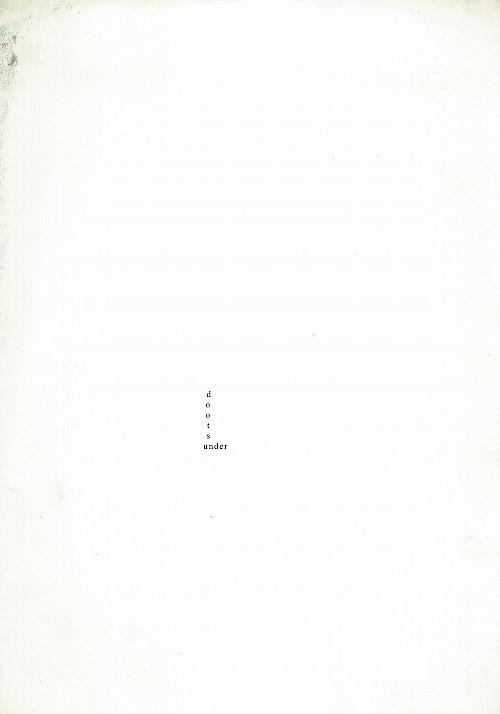
HK: I think that particular sentence you quoted is significant. It describes how I understand at least part of what I’m doing. In a sense, when I say we’re shoveling these fully crystallized forms out of our memories, they’re not the memories themselves. What I’m trying to say is that they are like a process of discovery in the work, as something that is meaningful. It’s meaningful and legible yet not fully understandable, and it’s also meaningful without being driven by intention. It’s not like sitting down at the drawing board and saying I’m going to make a comedy, for example. I’m going to write a joke to write a joke. I guess, for me, the medium is not the material. It’s not about the steel, for example. It’s not the actual material. It’s in that sentence: the medium is this virtual act of discovering something in your consciousness that escapes you, but is meaningful. It’s not a fantasy. In this case, memories are part of what gives meaning to what comes from experience; it comes from myself being constituted of human stuff, things we share, things we know. In a way, I treat myself and everyone else as the sum total of human experience even if I do not fully believe this as the truth. And if the work is imbued with memory in a way that makes sense, it becomes meaningful. In the text about humiliation, humiliation becomes the key to finding that meaning. But I don’t think it’s the only one.
NG: I feel that even in this conversation, the way commitments and contingencies are being threaded together in various works is useful; the formation of the actor and finding his or her story is not a sort of recklessness, producing eccentrics who are living outside social bodies or structures. It seems to be about the inside of characters. One of the early texts that you sent me was a text on Arwa Saleh and the archetypical intellectuals. You mentioned that this might be what came before your text in e-flux journal, “In Defense of the Corrupt Intellectual.”2Hassan Khan, “In Defense of the Corrupt Intellectual,” e-flux journal 18 (September 2010) → I was wondering how that trajectory moved—going from Arwa Saleh and carrying into thinking about corruption and the archetype of the intellectual.
HK: I read Arwa Saleh’s book, and I read it a lot. I actually knew her vaguely in ther early nineties, before she committed suicide, so I have memories of her. She knew my parents as well. But she was older than me. Her book was really one of the very few books I could find in Arabic that took a critical view of this sort of intellectual milieu. I thought it was very perceptive. It wasn’t just criticality. It was a real engaged and passionate response, because she was part of that scene, though she ultimately found it to be disappointing and unable to live up to its claims.3See Hassan Khan, “Archetypal Intellectuals, Devastated Revolutionaries, Kitsch Mythologies, and a Writer Who Dared to Look at Herself,” Bidoun 9 (2006) → Those very claims were grounded in something that was ultimately, one might say, corrupt.
One claim was a celebration of the role of the intellectual. And that leads to this strange break in which the intellectual becomes something like a state of exception. I’m sure you have this in other third-world countries, where the intellectual is supposed to play the role of enlightening the masses, leading the vanguard of the people and all that. And she discusses this through her own personal experiences, through a kind of portraiture of her own social interactions. And so it’s not just about political claims. It’s also about how certain claims are acted out in friendships and in a setting, in a scene. And that was important for me in the two texts where I called this phenomenon “the corrupt intellectual” as an attempt to analyze it.
It was about Egyptian cultural history. But also about analyzing what this specific role did over the past hundred years in the sociopolitical structure of the country, and how it was constitutive of a certain idea of the state that persists to this day. The second text, “A Monster Was Born,” looks at it through what happened in 2011 and the reclaiming of revolutionary potential by the state and by all these other powers. This reclamation was facilitated by arguments put forth by all these intellectuals. There is a common trope in Egyptian public media that repeats how the intellectual is marginalized, for example, and is unimportant and so forth. But actually this is not true. The intellectual is incredibly significant in a society like that. And actually, even the fact that the intellectual is seen as an inappropriate figure: this is part of its power. It’s this insidious figure that manages to determine the field or horizon of public meaning. And it’s not just the intellectual, as we understand it, but rather everyone involved in the endeavor of producing such a figure. It’s the poets and the playwrights. It’s the social scientists. It’s the artists.
NG: I think this is key, considering this question of the intellectual as someone producing a horizon of public meaning, and then constantly negotiating the texture of that visibility and relevance, or how those words or that relevance will resonate in the future. These relate closely with your other essay on the corrupt intellectual, actually.4Hassan Khan, “A Monster Was Born: Notes on the Rebirth of the ‘Corrupt Intellectual,’” e-flux journal 57 (September 2014) → It seems we have completed a circle of some kind.
×


